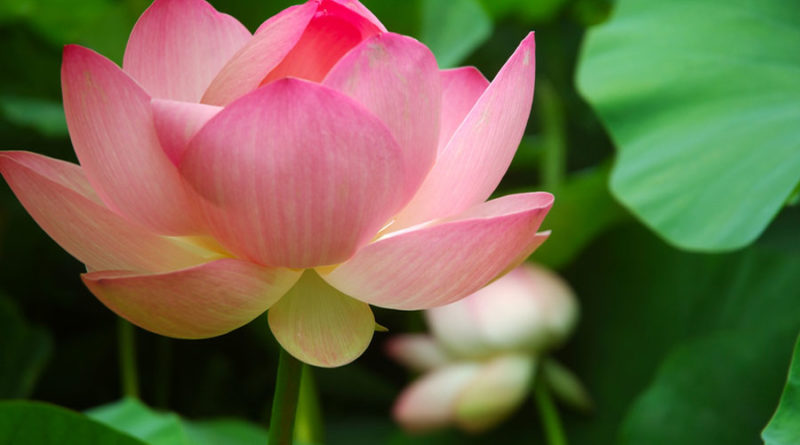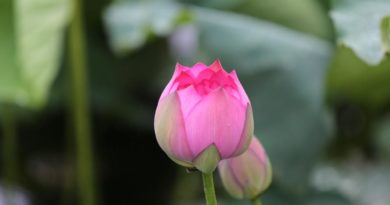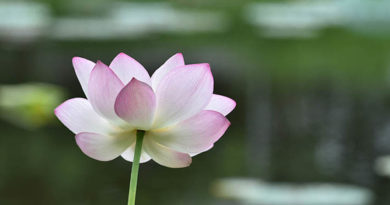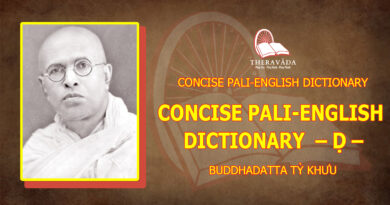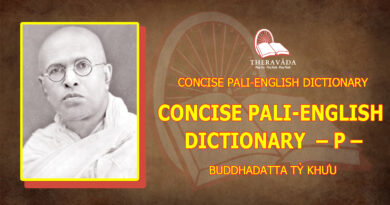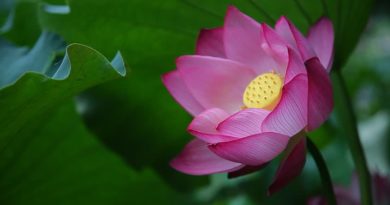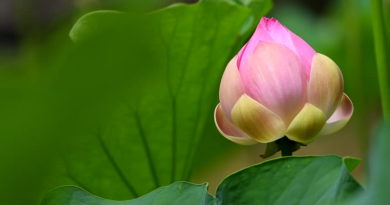USING VARIETY TO “FRESHEN UP” OUR MEDITATION – ANOTHER APPROACH, DOING DEEP SAMADHI FIRST
USING VARIETY TO “FRESHEN UP” OUR MEDITATION
ANOTHER APPROACH, DOING DEEP SAMADHI FIRST
Another way of doing loving-kindness meditation applies if you’ve done a lot of breath meditation and got a deep Samadhi, not necessarily into Jhanas, but at least some degree of Samadhi. Then you can take up loving-kindness. When you’ve already developed a degree of deep meditation or Samadhi and you take up loving-kindness, it’s so easy to do. If you’ve had a deep meditation and you start thinking about loving-kindness, you can spread it to the whole world so easily, because the mind is soft. You can work with the mind once its has done deep Samadhi. What Samadhi does to the mind is make it like a piece of clay. If clay is too dry, you can’t make it into anything. If it’s too wet and soggy, it just goes all over the place. But if there is just the right amount of water in that clay, you can turn it into all sorts of shapes. When there’s just the right amount of softness in the mind (as there is after deep meditation), you can turn it into anything. You can do beautiful loving-kindness meditation.
We used to do this chant in our monastery some time ago. It was the Four Divine Abidings (Brahmaviharas). We chanted the spreading of loving-kindness, (Metta) and then compassion (Karuna) and then sympathetic joy (Mudita) and then equanimity (Upekkha). We did this all in about five minutes. After one very nice meditation when we started doing this chant, I just got stuck on the first part (Metta) and I couldn’t go anywhere else. Just as soon as I started chanting, the mind was so workable, as it were, so easy to point towards whatever I wanted to, that as those words came up I was just immersed in loving-kindness. I couldn’t do anything else! I got stuck in loving-kindness, a really powerful loving-kindness as well. I never got to the second part of the chant.
This example shows what you can do with a mind that is well trained. You can really do loving-kindness meditation. I discovered from that experience that a lot of the loving-kindness I had done before was just messing around, scratching at the surface. So when you develop a very deep mind state on the breath meditation, it’s very good when you come out to do loving-kindness meditation and experience its power, experience its bliss. Direct it to all beings, and also include yourself. Because your mind has been empowered, loving-kindness is extremely strong, and it can really direct a lot of benefit towards yourself and towards other beings.
In Sum
So these are some of the ways of doing loving-kindness meditation, especially to: overcome the hindrance of ill will, be able to look at the breath kindly and to nurture the breath, give the mind something else to do so you’re not always doing breath meditation, and to get these very beneficial attitudes of forgiveness towards oneself and all other beings. This way one isn’t carrying around the faultfinding mind that sees all the mistakes in oneself, and in other beings, and in the world.
(To continue on with a “hands on” treatment of Metta, please turn to the Appendix. Enjoy!)
Letting Be, Letting Go Meditation
Another meditation object that I would like to discuss is the meditation on “letting be,” or “letting go”. This is one of the other meditations that I often practise. Sometimes instead of trying to watch the breath as my object, or taking loving-kindness as my object, I look at my mind and realise the best thing it needs at the moment is just to let things be. Basically, letting be meditation is just this second stage of breath meditation, just silent awareness of the present moment. It has to be silent, because to really let things go means you give no orders; you don’t have any complaints. If you really let things be, you’ve got nothing to say, nothing to talk about. “Letting be” happens in the present moment. You’re just aware of things as they’re appearing right now, and you allow them to come in. You allow them to stay. And you allow them to go whenever they want. Letting be meditation is like sitting here, and whoever comes in the door, you let them come in. They can stay as long as they like. If they are terrible demons, you allow them to come in and sit down. They can stay as long as they like, and you are not at all fazed. If the Buddha himself comes in all his glory, you just sit here, just the same, completely equanimous. “You can come in if you want.” “You can go whenever you want.” This is letting be meditation. Whatever comes into your mind, the beautiful or the gross, just stand back and let it be, with no reactions at all — quietly observing, practising silent awareness in the present moment.
The Garden Simile
I will now introduce the simile of “Just sitting out in the garden” to explain the letting be meditation more fully.
Many here in Australia have a garden at the back of their house and they often spend many hours working in their garden making it look beautiful. But a garden is to be enjoyed, not just to be worked in. So I advise my students that they should frequently just go sit in their “garden” and enjoy its great beauty.
The most stupid of my students decide that they must mow the grass first, then prune the bushes, water the flower bed, rake the leaves…..getting the garden perfect before they can sit down to enjoy it. Of course, the garden never is perfect no matter how hard they work. So they never get to rest in peace, except when they’re dead (R.I.P.)!
The second type of student also lacks wisdom. They decide not to do any work, but as soon as they sit out in their garden they begin to think. “The grass needs mowing and the bushes should be pruned. The flowers are looking dry and the leaves really need raking, and the nice native bush would look nice over there, and…..” When they are thinking how they can make the garden perfect they are not simply enjoying it. They find no peace.
The third type of student is the wise meditator. They have done a lot of work in their garden, but now is their time for rest. They say: “Even though the lawn could be mown, even though the bushes could be pruned, even though the flowers could be watered and the leaves raked…..Not now! The garden is good enough, natural even”. And they can rest a while, not feeling guilty in the midst of imperfection.
Letting be meditation is just the same. Don’t try and make everything perfect, tying up all those loose ends, before you let things be. Life is never perfect and duties are never finished. Don’t even think on how you can make this more perfect. Letting be is having the courage to sit quietly and rest the mind in the midst of imperfection, in spite of unfinished business. Let it be for now. The time for gardening work will come later.
Letting Be Can Become Quite Powerful
Letting be meditation can become quite powerful. If your breath meditation is not working, if Metta meditation doesn’t work, or you try any other type of meditation and it’s not working, very often it’s because you haven’t got the foundation correct. So just do the letting be meditation. You can just “sit out in the garden” and just let things be. Whatever is happening, that’s O.K. Whatever I’m experiencing is fine — no preference, no choice, no good, no bad, no argument and no commentary. “Just let things be.” You can have a little bit of a commentary inside but just the commentary about “Let be”, “Let things go”. Just be with what is; i.e. just be with the commentary that is about the meditation subject, but not about anything else. That way the meditation becomes close to complete silent awareness of the present moment.
You can use that meditation as I use it: if I’m in pain, got a headache or a stomachache or whatever other ache I have, or if the mosquitoes are biting. “Just let it be.” Don’t argue with it. Don’t get upset about it. Just watch the feelings in the body as the mosquito pushes its nose into your flesh followed by the itch that comes. “Just let things be.” Lying in bed at night and you can’t go to sleep. “Let it be.” Or there’s a pain that won’t go away. “Just let it be.” Just be with it. “Just let it be.” Don’t try running away. It’s like the demons have come into the room. You’re not going to try and push them away. You’re not going to invite them to stay either. You’re just going to let them be.
This is equanimity; this is the practice of letting be. And it is one of the other meditations that I do from time to time. It can be a useful addition to your repertoire.
Walking Meditation
Walking meditation is beautiful, especially in the early morning. Often when one gets up early in the morning, in particular when you’re not used to getting up early, you’re quite tired and the mind isn’t bright. One of the advantages of walking meditation is that you can’t nod while you’re walking. You don’t snore either! You’re awake because you have to be. So if you’re tired, walking meditation is very good to do. It brings up some energy, and also you can get very peaceful.
Walking meditation was both praised and practised by the Buddha. If you read the Suttas, (the teachings in the Pali Canon), you find that the Buddha would usually walk meditation in the early morning. He wouldn’t be sitting, he’d be walking.
Many monks and nuns became enlightened on the walking meditation path. It’s a very effective way of developing both calm and insight (but not to the extent of Jhana). For some monks that I know in Thailand, their main practice is walking meditation. They do very little sitting. They do a lot of walking, and many get tremendously powerful insights while they’re walking.
Another benefit of walking meditation is that it is especially suitable for those who have physical discomfort in sitting for long periods. If you find it difficult to sit meditation because of pains in the body, walking meditation can be very effective.
So please don’t look at walking meditation as a “second class” meditation. If you want to spend most of your meditation time this way, please do so. But do it well, do it carefully. See if you can develop that happiness born of serenity as you’re walking backwards and forwards.
Setting Up Walking Meditation
Choose a clear, straight path between twenty and thirty paces long. This can be a corridor in a house, a path in the garden or just a track on the grass. Use whatever is available, even if it’s a bit less than twenty paces long. If it’s comfortable to do so, walk without shoes, enjoying the contact of your bare feet on the ground.
Stand at one end of your path. Compose the mind. Relax the body and begin walking. Begin walking back and forth at a pace that seems natural to you. While you are walking, place your hands comfortably in front of you, and rest your gaze on the ground about two metres in front of you. Be careful not to look around. If you’re doing walking meditation, it’s a waste of time to look over here and look over there, because that would just distract the attention from the feet, where it should be.
The Stages of Meditation Apply Here Too
Do you remember the stages of meditation covered so carefully in the chapters on the basic method (Chapters Two and Three)? Well, the first four stages apply here too. But here attention eventually comes to rest on the foot rather than the breath.
At first, aim to develop present moment awareness, as in Stage one, described in Chapter Two, “The Basic Meditation: Part One”. Use the techniques described there to reach the state of just walking, easily, in the here-and-now. When you feel that you have settled into the present moment, where business to do with the past and future is absent from the mind, then aim to develop silent walking in the present moment. Just as in Stage Two as described in Chapter Two, gradually let go of all thinking. Walk without commentary. Make use of some of the techniques described in “The Basic Method” to reach this stage of silent walking. Thus you begin walking meditation by developing the same two initial stages as with sitting meditation.
Once the inner commentary has slowed to a bare trickle of inner speech, deliberately focus your attention on the feeling of movement in the feet and lower legs. Do so to the extent that you clearly notice every step on the path. Know every left step, know every right step – one after the other without missing one. Know every step as you turn around at the end of the path. The famous Chinese proverb of the “Journey of one thousand miles” is helpful here. Such a journey is in fact only one step long — that step which you are walking now. So, just be silently aware of this “one step” and let everything else go. When you have completed ten return trips up and down the path without missing one left step and without missing one right step, then you have fulfilled Stage Three of the walking meditation and may proceed to the next stage.
As the attention increases you notice every feeling of movement in the left step, from the very beginning when the left foot starts to move and lift up from the ground. Notice as it goes up, forward, down and then rests on the ground again, taking the weight of the body. Develop this continuous awareness of the left step and then similar smooth, unbroken awareness of the right step. Do this throughout every step to the end of the path. Then as you turn around notice every feeling in the turning-around movement, not missing a moment.
When you can walk for fifteen minutes or more comfortably sustaining the attention on every moment of walking, without a single break, then you have reached the Fourth Stage of walking meditation, full awareness of walking. At this point the process of walking so fully occupies the attention that the mind cannot be distracted. You know when this happens because the mind goes into a state of Samadhi (Sustained Attention) and becomes very peaceful.
Samadhi on the Walking Path
Even the sound of the birds disappears as your attention is fully taken up with the experience of walking. Your attention is easily concentrated on one thing, sustained on one thing, settled on one thing. You will find this a very pleasant experience indeed.
As your mindfulness increases, you get to know more and more of the sensations of walking. Then you find that walking does have this sense of beauty and peace to it. It becomes a “beautiful step”. And it can very easily absorb all your attention because you become fascinated and peaceful, just putting all your attention on walking. You can get a great deal of Samadhi through walking meditation in this way. That Samadhi is a sense of peacefulness, a sense of stillness, a sense of the mind just being very comfortable and very peaceful in it’s corner of the world.
I started my walking meditation when I first ordained as a monk in a temple in Thailand. I would choose a path, and quite naturally, without forcing it, I’d walk very slowly. (You don’t need to walk fast; you don’t need to walk slow; just do what feels comfortable). I used to get into beautiful Samadhi states during walking meditation. I recall once being disturbed because I’d been walking too long. I hadn’t noticed the time pass, and I was needed to go to a ceremony in this temple in Bangkok. One of the monks had been sent to go and get me. And I recall this monk came up to me and said, “Brahmavamso, you’ve got to come to a Dana“. I was looking at a space about two meters in front. My arms were in front of me, and my hands folded. When I heard that, it was as if hearing it from a thousand miles away, because I was so absorbed into what I was doing. He repeated, “Brahmavamso, you have to come now”. It took me about one minute to actually lift my head from the ground and to turn it around to the side where this senior monk was trying to get my attention. And as I met his eyes, all I could say was “Pardon?” It took such a long time to get out of that Samadhi and actually do anything quickly. The mind was so cool and so peaceful and so still.
I hope you experience this peacefulness for yourselves when you try walking meditation. Many people I’ve taught walking meditation to for the first time have said: “Wow! This is amazing. This is beautiful”. Just slowing down, you get into peace. You’re getting into calm by just watching the sensations as you walk. So this is one other type of meditation that I am suggesting to you, giving to you to experiment with.
Choosing the Right Meditation for the Right Time
Sometimes people ask when one should do which meditation. How do you choose what to do? A first, you should experiment with doing different meditations at different times. Eventually you’ll develop the wisdom which knows what your mind is like and what your mind needs. Observing is the way to find out what type of meditation to do.
Sometimes your practice is like working with a piece of wood from the wood yard. You want to make some furniture, say a meditation stool. The first thing you do is to look at the piece of wood. Usually, it needs to be planed down initially, and then you apply the roughest grade of sandpaper, then a medium grade, then a fine grade of sandpaper. After that you get out a polishing cloth with some wax or some oil; or if you want to, you coat it with varnish instead. But if you use a cloth, you use it only at the end, after you’ve used the finest sandpaper and the wood is really smooth. Only then do you get the cloth out and polish it up. This way it ends up as this beautiful, shiny, smooth piece of furniture. But you have to examine the piece of wood first of all. If you get a piece of wood from the wood yard just freshly sawn with all of the burrs on it and you get the polishing cloth out straight away, you’re going to ruin a lot of polishing cloths. And you’re not going to make that wood smooth at all. In meditation this is like trying to go too deep too fast.
If you look at your mind and it’s really rough and coarse and you want to go straight onto the Samadhi Nimitta, then you’re wasting your time. You’ve got to get the “plane” and the “sandpaper” out first of all. Sometimes it is the case that you get a piece of wood from the shop that is just so smooth already, that all you need to do is to use the polishing cloth. Sometimes you may sit down on that cushion and the mind is already so peaceful that you don’t need to go through all the preliminaries. You just go straight onto the breath, straight onto the beautiful breath, sometimes even straight onto the Samadhi Nimitta! So you look at your “piece of wood” — your mind. The skillful meditator in you knows what it needs. If it needs loving-kindness, O.K., spend a few minutes doing loving-kindness meditation. If it needs some “letting be” meditation because it’s quite coarse, just “take it out to the garden” and let it be. You know what it needs by looking at your mind and by recognising the state of the mind. This is similar to the insight practice of meditation that I’ll say more about in the next chapter. You recognise the problems, and you know the solutions.
Conclusion
So these are just some types of meditation. There’s a whole range of other types of meditation that I could discuss, but this is enough to practise for now. Just to sum up: I talked about Metta meditation. (Please do some, it is very important and you’ll find it’ll help the other meditations that you do.) I’ve discussed “letting be” meditation. And I’ve discussed walking meditation. Hopefully these ways of practice will help you, as well as sitting meditation. Try them out; see how they go. Also see if they don’t spill over into your daily life with wonderful effects.
Whatever You Are Doing, Do It With Everything You’ve Got
I’ll finish this chapter with one last story. I was with a teacher in Thailand for over nine years, quite a famous teacher in the world of Buddhism. An Australian man told one of his teachings to me many years after the teacher, Ajahn Chah, had stopped teaching. I never heard these instructions myself.
The man had gone to visit Ajahn Chah in the north east of Thailand, which was a difficult place to get to. He made a special journey, and when he got to this place — some seven hundred kilometres from Bangkok — he found that Ajahn Chah was surrounded with people. The man was on the outskirts of these people trying to ask the questions which he wanted to ask of this wise old monk, but he found that there was no way he was going to be able to catch his attention. There were just too many people.
The man had arranged for a taxi to come back and pick him up later to take him to the station to get the train back to Bangkok — an all night journey. The taxi wasn’t going to come back for another hour. He knew he wasn’t going to see the teacher and ask his profound questions. He saw some monks sweeping the paths in the monastery and he thought, “Well I’ve come all this way, I might as well do something useful”. He picked up a broom and started to sweep. He was sweeping the leaves from the path when he felt a hand on his shoulder. He turned around, and to his surprise and delight it was the teacher, Ajahn Chah. Ajahn Chah had seen this westerner coming and not having a chance to ask any questions, but unfortunately Ajahn Chah had only left the big group around him because he had another appointment himself. A car was waiting for him. So he just gave this young Australian man a very simple teaching. He told him, “If you are going to sweep, sweep with one hundred percent of what you’ve got”. Then he went away.
This man remembered this teaching that if you’re going to sweep, sweep with everything you’ve got. And he realised this was more than a teaching on how to keep the monastery clean. It was a teaching on how to live life. If you’re going to meditate, meditate with everything you’ve got; if you’re going to write a letter, write with everything you’ve got. If you’re going to brush you’re teeth, wash your car, take an exam, make that telephone call, speak with a person near you, give them everything you’ve got.
This is the way of Buddhist meditation. It’s not that hard! Try walking meditation; you’ll find it’s easy. Learn meditation on the breath, and you’ll find that easy too. Whatever you do in life: instead of doing it half-heartedly, quarter-heartedly or one-eighth-heartedly, give it everything you’ve got, and you will find that life will start to come together./.
Ajahn Brahmavamso
(“Dhamma Journal”, Buddhist Society of Western Australia, July 2001)
Appendix
Guided Loving-Kindness (Metta) Meditation
-ooOoo-
When we practise meditation it benefits not only ourselves, it brings happiness to many others as well. The calmer and more peaceful we become, the more we can give to others. If there’s no peace in our hearts, how can we give peace to anyone else? So when it comes to practising compassion, meditation is one of the kindest things that we can do for others. If we’ve built up some beautiful energy through meditation, then it is time to share that energy with other beings, recognizing that there is a connection between us all. What we do in our own meditation and practise does have a profound effect on all other beings throughout the universe. So this is why I will now describe a guided loving-kindness meditation.
Because this is a guided meditation, it might be better to experience it as the spoken word rather than the written word. Therefore you may want someone to read the instructions to you or perhaps better yet to actually tape record your own guided meditation. When guiding, it’s important to pause from time to time, and good places to do this are indicated in square brackets throughout the text.
First of all, sit down comfortably in a quiet place, close your eyes and give permission to your mind to let go of all burdens. Allow your mind to let go of all past and future, remembering that you deserve some peace. Be kind enough to grant yourself the gift that is the present. Be now, be gently. Now be kind to your body making sure it’s comfortable. Being so careful, because that is what careful means, “full of care.” See to it that even little things like your toes are all cared for to make sure they are comfortable. Go through each part of the body, relaxing the body and offering it some gratitude, some thanks, for allowing you to sit meditation. Sometimes you may have been quite hard on your body, but now thank it for giving you the opportunity to be at peace. Let’s care for this body, show it respect. Relax the body into a soft state of ease so it becomes a fine vehicle for loving kindness meditation.
Take a few minutes just to experience the body and bring it to ease.
[Pause]
Now let’s do a little bit of breath meditation. Begin with this breath which is feeding you the oxygen which brings all this good energy into the body. Show gratitude for this breath as it brings all this energy in, giving light, giving warmth, and giving that energy to each part of your body. Imagine the breath coming in and bringing golden light to every part of your body and then taking out all the used gases. Giving out into the world, as someone said, as a gift for the flowers and the trees that take the carbon dioxide as food. Breathing in with gratitude, with care, and breathing out as a gift to nature. Breathing in and out naturally with a sense of kindness and warmth towards this breath, giving a sense of kindness and warmth and gratitude towards this present moment. This present moment is giving you so much happiness and wisdom. Say thank you, to “now”.
[Pause]
Give gratitude to silence, the place where peace resides, the place where that bliss of freedom bubbles up like a spring from the ground. Give gratitude to the cool, clear, refreshing water of stillness. Breathe in so gently, so warmly. Look upon your breath in that silence as if it were a child born of your own body, a part of you, something which you caress with your mindfulness, with softness, with warmth, with care. Trust in that loving attention of mindfulness as you once trusted as a young child in the arms of your mother. Be unworried, unconcerned for the future, just as if you were a baby in the arms of your mother — being walked backwards and forwards with the breath, backwards and forwards as the breath goes in and the breath goes out.
Pause for a while. Enjoy the breath.
[Pause]
Now we will begin the loving kindness meditation. Choose an object in the mind’s eye — imagining a baby, a small kitten, a puppy or whatever object you can bring up into your mind through imagination. Choose an object towards which you find it easy to generate feelings of warmth, of love, of care. As you visualise that being in front of you, imagine it has only one person in this world to look after it and to care for it — you. If it were not for you, that small baby, kitten or puppy would surely die – would die of hunger and cold, or a lack of love.
See if you can look that being in the eye, and give it trust, give it kindness, give it care. Say to that imaginary being, “I have kindness and love towards you. I will look after you, feed you, protect you and love you no matter what happens. I will always be there for you”. As you bring that small kitten, puppy or baby into your arms close to your chest, still keeping that eye contact, feel the small being giving you back love, trust, kindness. Using whatever words, ideas, commentary which you can bring up, generate more kindness and care, more love towards that small being, such as saying to that imaginary being: “The door of my heart is always open to you. No matter what you ever do I will never take away my love, my care. My Metta is unconditional, unbounded with no limitations”.
[Pause]
You should now make that small being your very, very close friend. As you give that warmth, that Metta, that loving kindness — unbounded and unconditioned — to that small imaginary being, notice how it feels inside your own heart. When you give that love it creates this beautiful warmth, this golden light of loving-kindness. Just dwell on that imaginary being until that warmth and that flow of loving-kindness towards that kitten, puppy or baby is just so strong, as if that being is not imaginary at all but is real. Give it your wholehearted love, care and protection. “May you be happy and well forever. I truly care. Whatever you do, wherever you go, I will always give you my love.”
How does that golden glow of loving kindness towards another being feel inside? Pause for a while. Enjoy the feeling.
[Pause]
Now it’s as if that image of a kitten, puppy or a baby disappears and in it’s place is the image of somebody who is very close to you in life — it might be a husband or wife, a child, a parent or a close friend. Bring them up in front of you, imagining them in your mind’s eye, knowing that they too are fragile. Without your love and your care, they too will hurt, they too will suffer. So give the same warmth, kindness and unconditional love to this person whose life is very close to you. Say to them, “I care about you; I give you my loving kindness unconditionally. The door of my heart will always be open for you. No matter what you do I will never take away my loving kindness. I wish for your well-being and happiness. Your happiness is my concern, my life-long concern”. Give them that beautiful warm love. “May you really be happy; may you reach peace, reach Nibbana. May you be free from all suffering. If there is anything I can do to be of help in that quest, it is my privilege, my joy to help.”
As you give resolutions of loving kindness towards that person who is important in your life, who you are imagining in front of you, feel that golden glow in your heart. Feel the warmth of loving kindness. It’s as if you allow that golden glow to grow, to reach that person so close to you, to go all around them like a halo. Let the golden glow bathe them and give them energy, happiness and health. Stay with that glow. Say in your mind, “I wish you happiness and well-being; may you be at peace; may all suffering end for you.”
[Pause]
Now as you give that unconditional loving kindness towards your chosen person, allow that feeling of unconditional loving kindness to grow brighter and even more beautiful. Pause for a while. Just enjoy the feeling.
[Pause]
When you are ready, let go of the image of that person. Substitute another person you are close to. Repeat the process creating the feeling of Metta in the same way. Take as much time as you wish.
[Pause]
Now it’s as if that second close person has disappeared too. Without opening your eyes imagine a whole group of people, perhaps all the people in the house you are in. Develop the caring glow of Metta around them all. “May you all be happy and well…” See if you can imagine Metta to be a golden radiance coming from a beautiful white lotus flower in the middle of your heart. Give loving kindness to all the beings in your home (or other group), all the visible and the invisible beings. Give your loving kindness to all these fellow beings. Say to yourself: “I truly wish you all happiness and peace. The door of my heart in this moment and forever is always open to you; no matter what you ever do, you will always be my friends. I give my care to you, all my love, and my kindness. If there is anything I can do to ease your pain, it is my privilege to do so”. Bathe all the beings in your group in this increasingly splendid golden glow of loving kindness, “seeing” a halo around each person joining into a beautiful golden fire of care and goodwill and gratitude to all of them. As this golden glow of loving-kindness grows even greater, pause every now and again to feel what it’s like inside you.
[Pause]
As you give selfless love towards others, you find there is a beautiful warm peace inside your own heart, a silence, an energy.
Give that golden glow your attention once more and spread it out beyond the group you have chosen, to all the people in the city or town where you live. To all the people in your city or town today who are suffering, who know no peace, who are having arguments at home, who are lost and alone, never really appreciating or knowing love. Know their emptiness; fill it with your own love. Give that golden glow indiscriminately around the whole of the city or town. “May all these beings be happy and well. May they feel the same peace that I’m feeling now, and may they feel the same acceptance and security that I am feeling now. I give this golden light of love as a gift, to all beings in this city or town. May you all be happy and well. May you all be at peace. May you all have health and joy in your hearts.”
Pause again and enjoy the feeling. Savour it.
[Pause]
When you are ready, spread that golden glow wider and wider. Spread it to all the people in your home country. As it gets wider and wider, as it goes over the whole of this planet, it gets more beautiful. Say to yourself: “May all beings — human, animal and invisible — may all beings be happy. We are all friends in Samsara, in perpetual wandering from lifetime-to-lifetime; all beings are subject to old age, sickness and death just like me. I give you my happiness as a gift. I give you my love; the door of my heart will always be open to all beings. I wish you well. I wish you peace, sincerely, with all my heart. This moment is for you.”
Pause yet again.
[Pause]
Now direct your loving kindness towards the whole universe, telling yourself: “May all beings — great or small, invisible or visible — may all beings be free from suffering. May all beings realise the bliss of Enlightenment. May all beings know that ultimate happiness, selflessness, love, freedom and peace. This I give as a gift to all beings.”
[Pause]
As this beautiful golden glow spreads, notice how it feels inside — this unbounded, unconditional loving-kindness spreading over the whole universe. How does it feel inside you? How does it feel knowing that you are giving the whole universe that wonderful golden glow of love as you did to the images of people in your home, your best friend, a little kitten or puppy or baby?
Pause again.
[Pause]
When you are ready, put an image of yourself in front of you. Without opening your eyes, imagine you are watching in a mirror this person you have lived with since you were born, the one closest to you. Give yourself that golden glow. Say to yourself: “The door to my heart is open to me. I give myself my love, come inside.” Then say this to your own image, “I wish you all happiness and well-being; whatever faults you have I forgive. The door of my heart is open to me no matter what I have ever done.” Give unconditional love to this being inside, who we call “me.” Say to yourself: “I allow myself to be happy. I give myself permission to be free. May I be Enlightened. May I be at peace, free from all suffering.” Give yourself that beautiful warmth of love and kindness, indiscriminate, unconditional. Bathe yourself with the golden glow of Metta. Keep with that feeling of loving-kindness as long as you like. Enjoy it. Abide in it.
[Pause]
When you feel it is time to conclude, pause for another minute or two to reflect how you feel inside. Notice the effect that this meditation has had on you. Metta meditation can produce heavenly bliss.
[Pause]
Now imagine the golden glow of Metta one more time, arising from the beautiful white lotus in your heart. Gently draw that golden light back into the lotus, leaving the warmth outside. When the glow is a tiny ball of intense light in the middle of the lotus, gently close the petals, guarding the seed of Metta within your heart, ready to be released in your next Metta meditation. Now, when you are ready, open your eyes and get up slowly.
MAY ALL BEINGS BE HAPPY

